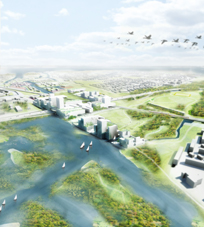Michael McDonough
Ton Venhoeven
Ahmet Hadrovic
Michael Braungart
Marcel Vroom
Wim Poelman
Rudi Daelmans
Martin Smit
Nirvana Pistoljevic
Natasa Perkovic
Sanja Durmisevic
Miriam Losse
Jan Brouwer
Martin Wollensak
Thomas Bednar
Maarten Dansen
Jaap Wiedenhoff
Adnan Pasic
Ivan Straus
Job Roos
Boran Pikula
Dzenana Bijedic
Haris Hadzialic
Ejub Dzaferovic
Almedina Hadzic
Alisa Grabus
Sanela Klaric
Azra Korjenic
Ken Yeang
Dushko Bogunovich

Lecture:
Mobile infrastructure modules in green cities
18:15h
Day One, Friday 09 September
Collegium Artisticum
TON VENHOEVEN
In his position of Chief Government Advisor Ton Venhoeven advises the Dutch government on spatial quality in complex infrastructural projects and sustainable urban developments. His tasks include a/o creating conditions for sustainable development of cities in relation to national and regional infrastructure and safeguarding environmental quality regarding spatial integration of infrastructure. As Chief Government Advisor on Infrastructure, Ton Venhoeven is a member of the Board of National Government advisors, which also includes the Chief Government Architect, the Chief Government Landscape Advisor and the Chief Government Advisor on Cultural Heritage. Together with Arup, TNO, DGMR and the Technical University of Delft, Ton Venhoeven is working on the development of the ‘Green Region Calculator’, a tool that will be able to measure the sustainability performance of urban regions.
Ton Venhoeven is Board member of the Research Department of the Royal Institute of Dutch Architects, a member of the Advisory Board Dutch Centre for Health Assets, part of TNO, and a member of the Advisory Board Architecture in Health. From 2005 until 2009 he was professor Architectural History and Theory at the Technical University of Eindhoven.
Ton Venhoeven regularly sits on juries for prestigious (inter)national competitions and awards. Recently, Ton was jury member of the Architecture Award Almere and the Hedy d’Ancona Award for excellent care architecture. In 2011 Ton Venhoeven is chairman of the Ymere/NAi Award jury.
He is also a much coveted (key note) speaker on sustainable urban developments. He has been invited to speak at the 24th World Congress of Architecture in Tokyo in September 2011.
www.venhoevencs.nl
www.collegevanrijksadviseurs.nl
In many architectural discourses, sustainability is strongly related to the design of buildings, or at best to the design of relatively small urban areas. The relevance and opportunities of the networks that these buildings and areas are part of are often overlooked. With sometimes disturbing consequences. Supposedly sustainable buildings in a beautiful countryside can cause very inefficient transport flows and the tonnes of CO2 that go with it, if they are situated in the wrong location. Choosing the right location for a less sophisticated building on the contrary, can lead to a very sustainable overall solution. As a result of globalization, mobility is expected to grow worldwide by around 100% before the year 2040. Needless to say that this creates a huge challenge for sustainability policy and design. Clever planning and political will can guide this growth in the direction of the most sustainable options. An important option is the creation of multimodal mobility networks. In these networks the formerly independent modalities of train, car and bicycle are united in one bigger integrated mobility network, with lots of chances for zero emission pedestrians, cyclists, public transport and electric cars. Multimodal nodes create optional switches between modalities. Densification with mixed functions around these nodes transforms these places into attractive city centers of smaller and bigger poly nuclear urban regions.
But networks offer more possibilities to increase sustainability. Just think about the communication networks needed to find clients for your byproduct, or think of the opportunities that networks like smart grids offer to eliminate the fluctuations in sustainable (wind, solar) energy production. All sustainable production depends on the availability of proper networks. Greenhouses for example produce an abundance of heat that can be used for heating offices and houses during winter if you can store the heat of the summer and if the users of this excess heat are near enough to prevent heat loss in transportation. (Of course the transportation network for heat must be available to begin with.) And greenhouses consume tonnes of CO2 as fertilizer for plant growth, a gas that is produced elsewhere as a noxious byproduct of the production of electricity. This gas can be transported over long distances without the loss of its energy. These and many other imbalances can be used to great advantage if there are appropriate networks that enable the exchange of these byproducts and waste. Clever planning can create the networks and the appropriate zoning to enable and stimulate the exchange of sustainable production and interesting waste. Networks and nodes create unlimited options for sustainable growth.
In his lecture, Ton Venhoeven will focus on the larger picture of sustainable building: the challenges related to the creation of sustainable urban regions and the opportunities that networks offer.

